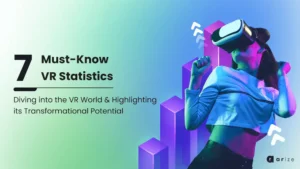Many people need clarification about how and why many companies adopt XR tech. From small start-ups to significant brand giants, various techs are integrated into companies in multiple ways.
While we’ve already looked at the different extended reality (XR) techs and their applications, let’s look at the three main reasons people are opening themselves up to those benefits.
What is Extended Reality?
Before we look at the reasons, let’s clarify the meaning of XR and what comes under that term.
XR is an emerging umbrella term for all immersive technologies. The ones we already have today—augmented reality (AR), virtual reality (VR), and mixed reality (MR) plus are still to be created. All immersive technologies extend the reality we experience by relating the virtual and “real” world, building a fully immersive experience.
Augmented Reality – In AR, virtual information and objects are overlaid in the real world.
Virtual Reality – In a virtual reality experience, users are fully immersed in a simulated digital environment.
Mixed Reality – In mixed reality, digital and real-world objects co-exist and can interact in real time.
XR Opens Up Business Opportunities
As XR tech becomes more readily available and cheaper to operate and integrate, it opens up opportunities unavailable to companies.
XR makes it possible to offer interactive, experiential marketing to consumers. Fewer field service operators collaborate remotely and let brands offer “try before you buy” services to consumers. It has also modified how businesses approach product development and simulation-based training.
XR Helps Cut Costs
Specifically, the cost of training new workers or teaching new processes and procedures to the workforce.
XR offers risk-free learning environments so trainees can make mistakes and learn from them without worrying about wasting resources or needing more resources to repeat the process they are learning multiple times.
It also allows dangerous or “in the field” situations to be replicated closely, making trainees better prepared for those situations instead of theoretically learning about them on a screen.
Additionally, XR training promotes high engagement levels and better retention among learners.
XR Allows You to Reach A Large Audience
While brands and companies may have explored XR technologies for some time, consumers have recently become aware of them.
Users can now access XR technology more readily through smart devices than a few years ago.
In some places, XR technology was only legal in more recent years. When it was legal, it was highly cost-prohibitive, meaning any investment in AR would have been playing to a tiny audience.
The cost of technology to produce XR experiences and access them has been dramatically reduced. Billions of people have access to smartphones and laptops at the very least, and they can experience XR through them.
Conclusion
A survey from Visual Capitalist in 2019 found that 60% of people questioned believed that XR technology would be mainstream in the next five years; three years later, it already is. While the pandemic may have accelerated the adoption rate, XR is here to stay, and if you want to keep ahead in your industry, it needs to be a part of your strategy.
To learn more about XR tech and how to use it to boost your business, visit https://arize.eden.com.co/ and contact us today.



